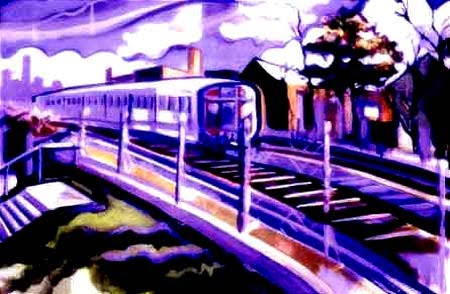Featuring a moderately-sized passenger waiting area, ticket counters, baggage check facilities, wide platforms, and a freight office, the Santa Fe's Fresno station represents the quintessential smaller city train station. It is inviting, well laid-out, and speaks to the railroad's presence in the city. Fortunately, the Santa Fe depot is in full use today as a train station, hosting Amtrak's five daily roundtrip San Joaquins trains north to Oakland and Sacramento and south to Bakersfield. The photos below illustrate the facility's fine standard of upkeep to this day.


Meanwhile, westward down Tulare Street at the intersection of the Union Pacific tracks lies the former Southern Pacific depot. Union Pacific inherited the Southern Pacific (SP) – which itself grew out of the Central Pacific – route when the two roads merged in 1996. The SP built its first station at the same location in 1872, and the current facility replaced its predecessor in 1889. The station marked a sharp contrast with most of the railroad's other railroad buildings, which featured a more boxy, red brick-and-wood style. Instead, its Fresno depot was fashioned in the Queen Anne architectural tradition, included rounded turrets, interior tunnel hallways, and a hipped roof. Full details on the history and architectural features of the Southern Pacific depot can be found here.
As passenger traffic on the line declined after the 1950's, the Southern Pacific was forced to abandon the station in 1971, when Amtrak assumed all passenger rail service in the nation and discontinued service to the San Joaquin valley. When service was restored in 1974, the San Joaquin trains instead served the Santa Fe station. Today, the station is listed on the National Register of Historic Places ensuring its continued preservation and is home to commercial and retail tenants. Trackside access to the Union Pacific right-of-way is prevented via a retaining wall. Also nearby is Chukchansi Park, home to the Fresno Grizzlies, a AAA affiliate of the San Francisco Giants, continuing the fine tradition of locating ballparks in close proximity to railroad infrastructure (see first photo below).


The eventual route of California's high-speed rail system is expected to pass next to the Southern Pacific depot and include a new station at the location. The project is anticipated to anchor development at the west end of downtown Fresno by leveraging nearby Chuckansi Park along with the new rail station. See my previous post on high-speed rail in California for further details.
Coming soon will be another look at one of California's historic rail depots: Sacramento's Valley Station, which serves as an outstanding example of true intermodalism, offering intercity rail and bus service, along with Sacramento Regional Transit's local light-rail and bus operations, taxi options, bicycle and pedestrian access.











Welcome to the blogosphere! I love your blogroll!
ReplyDeleteThanks. Looking forward to Sacramento story. I wonder what will happen to the San Joaquins if California high speed rail ever becomes a reality, because superb hi-level equipment (especially the classic cafe-tavern-lounge) on these trains is far superior to anything found on high speed trains anywhere in the world. Of course at 65 I doubt if I'll ever see high speed rail in the United States.
ReplyDeleteBeen awhile. What's happening Rich?
ReplyDelete